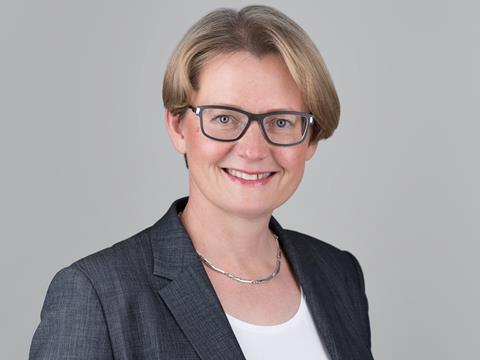
A year after the launch of its PepsiCo Positive (pep+) campaign, PepsiCo continues to push for 100% of its packaging to be recyclable, compostable, biodegradable, or reusable by 2025; for a 50% reduction of virgin plastic and the implementation of new business models to cut down on single-use materials by 2030; and for net-zero emissions across its value chain by 2040. We spoke to Katharina Stenholm, PepsiCo’s new Chief Sustainability Officer and Senior Vice President, to check in on the company’s progress and her role within it.
First things first, could you give us a bit of background on your previous experience in the packaging/FMCG space?
I joined PepsiCo from Danone where I was leading the global Procurement and Nature Sustainability teams, including delivering their Nature sustainability agenda across the business and into sourcing strategies. Prior to Danone, I worked as CPO at SABMiller (now AB InBev) and CEO of the Polttimo Group.
What exactly does your new role entail – what are your key responsibilities?
With last year’s announcement of PepsiCo Positive (pep+) – our end-to-end, strategic transformation plan – my role will accelerate the delivery of the agenda across all parts of the business in Europe and will integrate sustainability considerations into all our business planning and decision-making processes.
What are the key packaging-related objectives and challenges associated with your role?
We are pleased with the progress we have made in Europe with our commitments towards 100% rPET so far. At present, we have announced that 10 European markets are on track to make the switch for Pepsi by the end of this year.
Now, our key objective is to have 100% of our packaging recyclable, compostable, biodegradable, or reusable by 2025, so we are exploring feasible solutions across each market. This year, PepsiCo Europe also set a new ambition for all our snack packaging to use 100% recycled and renewable content by 2030, and we are already doing market trials with innovative materials to help us achieve this.
But there are challenges to overcome, such as limitations of existing recycling technology, building the right recycling infrastructure, and the regulatory environment. Yet our commitment to continue to strive toward these goals is unwavering.
PepsiCo’s critics say that it, along with other major brand owners, facilitates and is responsible for wide-scale plastic pollution on a global level. How would you respond to accusations like this?
Protecting our people and planet is very important to us and we share people’s concerns about litter. Our vision is to build a world where packaging never becomes waste, as we set out in our strategic transformation plan.
At PepsiCo, we aim to achieve our sustainable plastics vision through reducing, recycling, and reinventing.
Our ambition is to make a circular economy for packaging a reality. That means maximising recyclability, investing in recycling infrastructure, and using recycled content. We are also looking at options for reusable formats to reduce the overall amount of packaging material used. But this takes coordinated action by multiple stakeholders – collaboration is key to driving change.
Earlier this year, we announced plans to eliminate virgin fossil-based plastic in all our crisp and chip bags in accordance with our goal of 100% sustainability by 2025.
We also believe that deposit return schemes can provide a critical source of high-quality, clean recyclate, which is why we continue to be supportive of well-designed schemes.
We are investing in strategies that go Beyond the Bottle through reusable platforms like our global SodaStream business, which offers products in 45 countries around the world. For the circular economy to become a reality, we also need to use our iconic brands to inspire consumers to recycle.
What is PepsiCo Positive, and could you unpack the parts that relate to packaging?
PepsiCo Positive (pep+) is a strategic end-to-end business transformation with sustainability and human capital at the centre of how the company will create growth and value.
pep+ is embedded in every part of PepsiCo’s business and our 2021 ESG Summary details our progress and real-world examples of action across three pillars – Positive Agriculture, Positive Value Chain and Positive Choices.
Under the Positive Value Chain pillar, we announced an ambition to eliminate virgin fossil-based plastic in all crisp and chip bags to reduce GHG emissions from film packaging for food by up to 40%. We started consumer trials in European markets this year, with 50% of renewable polypropylene packaging in Lay’s Ancienne and Paysanne brands in France. Furthermore, a recycled plastic pilot is planned for the UK by the end of 2022.
Last question – do you have a message for your packaging suppliers and the rest of the value chain?
Collaboration across the entire value chain is of utmost importance to us. Tapping into the experience of our suppliers and partners, whilst leveraging technical and digital data capabilities, is critical to our success.
To achieve our net-zero carbon commitment by 2040, we will need all our suppliers to do their part to reduce GHG emissions, being part of our Scope 3 emissions. When designing for recyclability and a circular economy, we have to strive for the reduction of our carbon footprint in parallel.
Together with our suppliers, we will have to continue to innovate – in line with our philosophy of reducing, recycling, and reinventing packaging.
The shift to circularity is accelerating and it is vital that all actors in the packaging system build a shared vision of the future and act together to make it happen.


















No comments yet